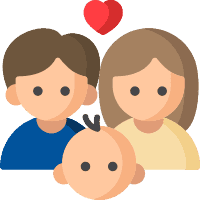Broadly speaking, children have an impressive ability to learn and synthesize speech by doing little other than listening. So when something interferes with a child’s ability to understand the spoken word, there can be significant consequences to communication-based abilities.
In general, difficulties processing language is usually referred to as a receptive language disorder. This disorder may present quite young and can be addressed through speech-language therapy.
What Are the Symptoms of Receptive Language Disorder?
Researchers are not entirely sure what causes receptive language disorders in children, but they suspect a combination of genetic, physiological, and environmental factors could play a role. To a certain degree, every youth will be different. That can also be true when it comes to symptoms.
For some kiddos, a receptive language disorder can be pretty easy to spot. But that’s not true for everyone. Teens diagnosed with a receptive language disorder, for example, may be able to trace their symptoms back to early childhood.
Usually, kids with a receptive language disorder will display some combination of the following symptoms:
- Disinterest in activities that involve listening, such as story time.
- Difficulty describing, remembering or sequencing a simple story or recent experience (age dependent)
- Difficulty executing requests
- Having trouble understanding the meaning of entire sentences or single words (or a combination of both).
- Using replacement words or filler sounds (ex: using “things” instead of more specific words or filling sentences with lots of “um” sounds)
- A limited vocabulary, especially when compared to same aged peers.
- Difficulty learning or remembering new words.
- Repeating what someone says after or while they are speaking
Some less common symptoms may be more challenging to detect. In fact, the precise presentation will vary from child to child. It’s also worth noting that receptive language disorders will often, by their nature, be impacted by other issues as the child develops.
Whether a receptive language disorder is a root cause in and of itself or due in part to other conditions is something that your speech-language therapist can assess. The therapy design for your child may change accordingly. It’s also common that receptive language disorders may exist in isolation, with no other associated conditions present.
How is Receptive Language Disorder Treated?
It’s worth noting that receptive language disorders are not caused by physiological issues with the ears or with hearing. While hearing loss can impact speech proficiencies, such disorders are usually categorized–and treated–differently.
Receptive language disorders are treated most effectively by a speech-language pathologist. Therapies for receptive language disorder are varied, but they may involve at least some of the following strategies:
- Vocabulary development: A speech-language therapist will work with your child to expand and develop their vocabulary to a level appropriate for their age.
- Learning Strategies: Because a receptive language disorder interferes with a child’s ability to understand language, many children benefit from learning strategies that will help them throughout their day. These strategies may include: reauditorizing what someone says, giving a child small pieces of information and then building on content, or self-cueing.
- Multisensory techniques: As the name implies, multisensory approaches engage multiple senses–touch, smell, sight, even taste–in addition to hearing. Using multimodalities typically helps children build more robust neurological connections.
Some of these therapies may be available in classroom settings. Other therapies will require dedicated, out-of-class sessions with a speech therapist. Parents can be instrumental in helping their children or teens with receptive language disorders succeed in speech therapy. The best things parents can do include:
- Starting early: When some parents notice the first signs of receptive language disorder, they may be tempted to take a “wait and see” approach. That can be detrimental in the long run. Generally, the earlier children start with speech-language therapy, the more quickly a child can begin using learned strategies. The same is true for teens with receptive language disorders!
- Make time for speech therapy: Ensure your children are getting to their speech-language therapy sessions on time and at the recommended intervals. When your kiddo misses a session (or more than one), that can present a setback.
Speech-language pathologists can recommend a wide variety of at-home activities for parents who want to work with their kids to improve auditory processing skills. From conversational games to repetition exercises, these activities are designed to be fun and provide practice for essential receptive language capabilities. You can find some ideas for activities on the web, or talk to your speech-language therapist for more.
Receptive Language Disorders Can Be Treated
The vast majority of receptive language disorders are first noticed in children–usually around age 3. With the right treatment and prescribed therapies, most kids can successfully grow up to have full, communicative lives. So if you have questions about receptive language therapy, or if you’re worried your kiddo might have a receptive language disorder, contact our offices to schedule an appointment or attend a free virtual visit during our free office hours to talk to a Speech Language Pathologist.



